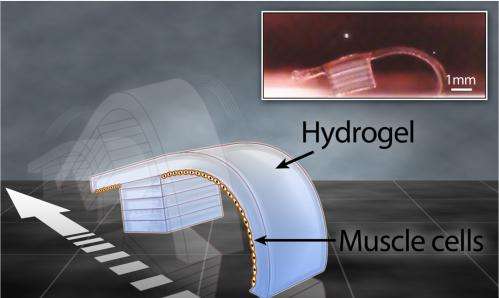These bots were made for walking: Cells power biological machines

They're soft, biocompatible, about 7 millimeters long – and, incredibly, able to walk by themselves. Miniature "bio-bots" developed at the University of Illinois are making tracks in synthetic biology.
Designing non-electronic biological machines has been a riddle that scientists at the interface of biology and engineering have struggled to solve. The walking bio-bots demonstrate the Illinois team's ability to forward-engineer functional machines using only hydrogel, heart cells and a 3-D printer.
With an altered design, the bio-bots could be customized for specific applications in medicine, energy or the environment. The research team, led by U. of I. professor Rashid Bashir, published its results in the journal Scientific Reports.
"The idea is that, by being able to design with biological structures, we can harness the power of cells and nature to address challenges facing society," said Bashir, an Abel Bliss Professor of Engineering. "As engineers, we've always built things with hard materials, materials that are very predictable. Yet there are a lot of applications where nature solves a problem in such an elegant way. Can we replicate some of that if we can understand how to put things together with cells?"
The key to the bio-bots' locomotion is asymmetry. Resembling a tiny springboard, each bot has one long, thin leg resting on a stout supporting leg. The thin leg is covered with rat cardiac cells. When the heart cells beat, the long leg pulses, propelling the bio-bot forward.
The team uses a 3-D printing method common in rapid prototyping to make the main body of the bot from hydrogel, a soft gelatin-like polymer. This approach allowed the researchers to explore various conformations and adjust their design for maximum speed. The ease of quickly altering design also will allow them to build and test other configurations with an eye toward potential applications.
For example, Bashir envisions the bio-bots being used for drug screening or chemical analysis, since the bots' motion can indicate how the cells are responding to the environment. By integrating cells that respond to certain stimuli, such as chemical gradients, the bio-bots could be used as sensors.
"Our goal is to see if we can get this thing to move toward chemical gradients, so we could eventually design something that can look for a specific toxin and then try to neutralize it," said Bashir, who also is a professor of electrical and computer engineering, and of bioengineering. "Now you can think about a sensor that's moving and constantly sampling and doing something useful, in medicine and the environment. The applications could be many, depending on what cell types we use and where we want to go with it."
Next, the team will work to enhance control and function, such as integrating neurons to direct motion or cells that respond to light. They are also working on creating robots of different shapes, different numbers of legs, and robots that could climb slopes or steps.
"The idea here is that you can do it by forward-engineering," said Bashir, who is the director of the Micro and Nanotechnology Laboratory. "We have the design rules to make these millimeter-scale shapes and different physical architectures, which hasn't been done with this level of control. What we want to do now is add more functionality to it."
"I think we are just beginning to scratch the surface in this regard," said graduate student Vincent Chan, first author of the paper. "That is what's so exciting about this technology – to be able to exploit some of nature's unique capabilities and utilize it for other beneficial purposes or functions."
More information: The paper, "Development of Miniaturized Walking Biological Machines," is available online at www.nature.com/srep/2012/12111 … /full/srep00857.html
See another video at http://ow.ly/fjOfJ.
Journal information: Scientific Reports
Provided by University of Illinois at Urbana-Champaign




















